QuestionQUESTION: Hi there. We have had a beautiful female rabbit for about two years ago. Recently my sister gave us another rabbit, whom she assured us was female. About 5 weeks ago I went out and found one tiny baby rabbit lying in the middle of the hutch. I removed the male rabbit immediately, and carefully placed the baby back in he sheltered area. I watched the mother to see if she would nest or anything, and she just ignored the baby except to walk over it. A couple of hours later it was dead. I cleaned out the whole hutch, and the next morning found 4 more dead baby rabbits strewn around the hutch. I kept the male and female separate, but while I was away on holidays, the male escaped and my neighbour caught him and put him back with the female. Yesterday I went out and found 3 more baby rabbits in her hutch. The mother had not made a nest, and the babies were scattered all over the place. I bought the mother and the babies inside and put them into a box to try and encourage her to care for them. I went to work, and when I retured home 3 hours later I was horrified to discover the mother had completely dismembered one of the babies, and the other two were scattered again. I phoned the vet, who suggested I try raising the babies. I bought some rabbit milk replacer from the vet, and fed them once last night and once today. I have read everywhere that babies this young will probably not survive, but I was wondering if there ever have been baies that have successfully been hand reared?
ANSWER: Hi Kim....we have also been visited by the "gender fairy"....that's our term when we think we have one sex but find we have another. I would urge you to have your rabbits fixed as there are so many rabbits that are looking for homes (and the unlucky ones have been "set free").
My first concern is with the vet. Very few..and I mean very few vets have the knowledge to advise on hand raising rabbits. Rabbits are the most challenging animal in which to hand raise. This is due to the unique design of a rabbit's digestive system. I routinely raise wild rabbits and many are found as newborns....we call them "pinkys". First, they are born sterile....they have no beneficial bacteria in their digestive system to digest food....and they have no antibodies to fight infections and they are very prone to infections in the first few days. Kits (baby rabbits are called kittens for some reason) are totally helpless. They can't control their body temperature. Maintaining body temperature around normal body temp of 101-103F is crucial. They become hypothermic and suffer organ failure quickly as they chill...and this happens even at room temperature. Feeding them presents serious challenges. Very few have any sucking reflex. When untrained people attempt to hand feed with a dropper or syringe it provides too much formula. This formula goes into the lungs (called aspiration). A sign of this is "blowing bubbles". This will quickly lead to a condition known as aspiration pneumonia and is very difficult to treat, requires aggressive antibiotics that are not good for any rabbit much less babies and the condition will usually result in death....basically by drowning. The safest and most effective way of feeding a baby rabbit is by "tubing". It involves putting a catheter down the esophagus and feeding directly into the stomach...tricky but very effective if you can master the technique. I am also concerned about the "rabbit formula" your vet sold you. There is no appropriate formula made for rabbits. Most often people attempt to feed them cow's milk, evaporated or scaled cow's milk. If they don't die from aspirating formula, they die from the lactose in these milks. They require a low or trace lactose formula. Many vets give milk replacers for kittens (kittens are obligate carnivores and rabbits are obligate herbivores which makes the guts and nutritional requirements very different) or goat's milk which is far insufficient in nutrition long term. I mix several professional formulas to come up with something as close to mother's milk as possible....and even us licensed rehabbers don't have a milk to match a mother rabbit. In nature, mother rabbits usually feed only once or maybe twice a day. It's usually very early in the morning. It seems to match the time when most natural predators aren't out in large numbers....the night predators have already eaten and the day predators aren't out yet. She feeds standing over the babies so if a predator approaches she can make a quick exit. She can feed, groom and stimulate her babies to go to the bathroom all in a few minutes. She then leave them alone so as not to attract attention to them until it's time for the next feeding. Her milk is very powerful and when she can feed as nature intended, her milk will add weight to them quickly. This behavior is common to both domestic and wild rabbits...they are with their babies only long enough to feed. In domestic rabbits, in order to satisfy this natural behavior, it's important to provide her with a nest box for her babies and an area she can "hide" from perceived predators. The next problem is populating the digestive system with beneficial bacterial. This bacteria comes in the form of cecals....aka night poops...from the mother. A rabbit has an organ, called a cecum, that is designed to help extract as much nutrition from things such as grass and bark as possible. Usually during the night, the rabbit stimulates it's anus and the cecum excretes these night poops....and they eat them. The cecals contain undigested food, vitamins and bacteria vital to a properly functioning gut. The babies get these from their mother. The bacteria starts to reproduce as the digestive system starts to stabilize. To get a "ready gut"....the pH in the gut must change from a fairly neutral pH of about 6 to an acidic pH of about 1-2. This is done via the mother's milk. If this conversion doesn't work right....the rabbit will die from a condition known as cecal dysbiosis....basically it's like a form of food poisoning and is normally caused by a harmful bacteria known as clostridium. I have worked up a protocol using a product called a probiotic....Bene Bac specifically. It has strains of bacteria that are very helpful at converting and stibilizing the weaning gut....L Casei and Enterococcus. Many have suggested using yogurt....but yogurt contains milk and sugar which are enemies of a rabbit's gut and should not be used.
Having said all of that....and it's a very condensed version of what happens in a rabbits....yes, it is possible to hand raise and wean rabbits. Is it easy?...not at all....as I mentioned, rabbits are the most notorious animals in wildlife rescue...and for the most part, the raising of baby domestics and wild rabbits are identical. If you would like more details....and specifically what to do almost day by day....I can do that for you. It would probably be better to do that in private as it is long and involved.
---------- FOLLOW-UP ----------
QUESTION: Thank you so much for such a complex answer. The rabbits have now survived the first 48 hours. I have only fed them once a day with a dropper...dropping one drop of milk onto their lips and watching them lick it off and swallow before I put any more on there. Some sites I read said to feed them every two hours, but they dont seem interested. I have a towel in the basket where they are, and they area able to sleep under it and move out as they need to. I also found some fur from the mother (not much but it seems enough) to put in there as well. Here is the website for the milk replacer I have.
My email address is if you are interested in talking more.
Thanks
AnswerHi Kim,
Neither the link to the milk site or your e-mail came thru. Try to resend it. Or write me at ra7751@gmail.com The best possible formula you can use that you can get quickly is Esbilac Puppy Powder..it has to be the puppy powder. They should be fed lying on their back. They should be fed twice a day (every 12 hours). Weigh them (in grams). They should be fed 10% of their body weight each feeding (50g divided by 10=5cc). It should be warm to the touch. They can't use the bathroom so you will have to stimulate their rear end...I use a Q Tip dipped in warm water. Those kits are still alive from the nourishment they received from mom...things will start becoming your responsibility over the next day or so. Weigh them every day...they have to gain weight every day. Weigh them before you feed them. You are in for a challenge. Most rabbits raised by hand do not survive. The first 5 days and the time around full weaning are the most difficult due to the major changes in the dynamics and climate in the gut. I wish you luck....and we can talk off forum.

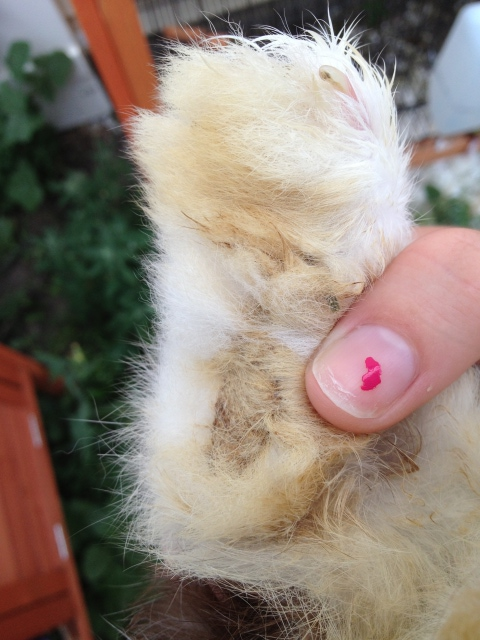 Sore hock HELP!
Question
Foot
Hey guys,
I bought this rabbit in
Sore hock HELP!
Question
Foot
Hey guys,
I bought this rabbit in
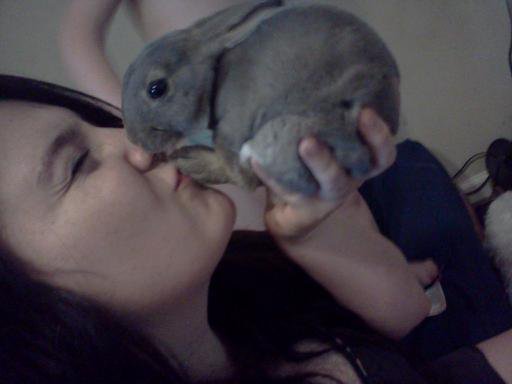 About how old is she?
Question
Thumper Dumper
Hello, I have a Female Mini Rex
About how old is she?
Question
Thumper Dumper
Hello, I have a Female Mini Rex
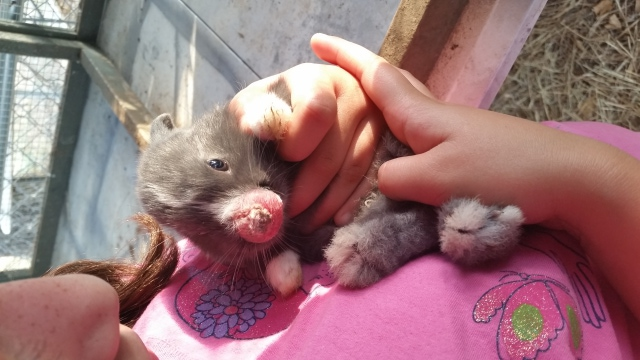 enlarge nose
QuestionQUESTION: 3 of my 5 bunnies have developed an e
enlarge nose
QuestionQUESTION: 3 of my 5 bunnies have developed an e
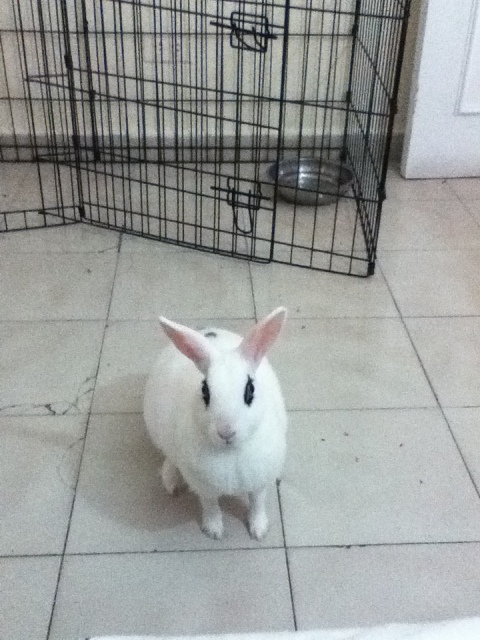 GI Statis ?
Question
COOKIE
Female/age 3yrs/house rabbit/open cage
GI Statis ?
Question
COOKIE
Female/age 3yrs/house rabbit/open cage
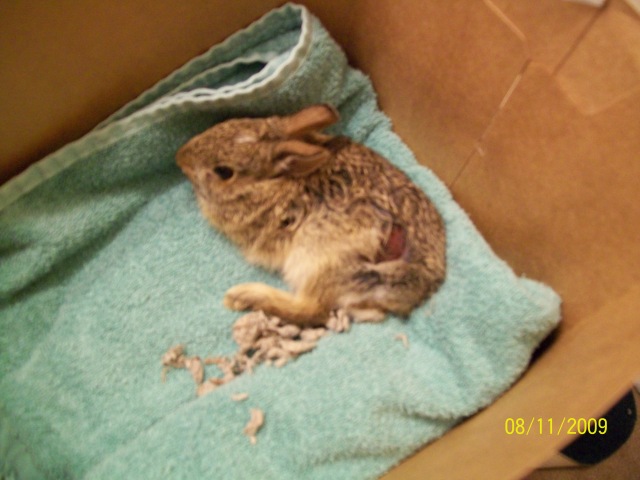 Orphaned and hurt
QuestionQUESTION: Hi i have 3 outside labs and by natur
Orphaned and hurt
QuestionQUESTION: Hi i have 3 outside labs and by natur